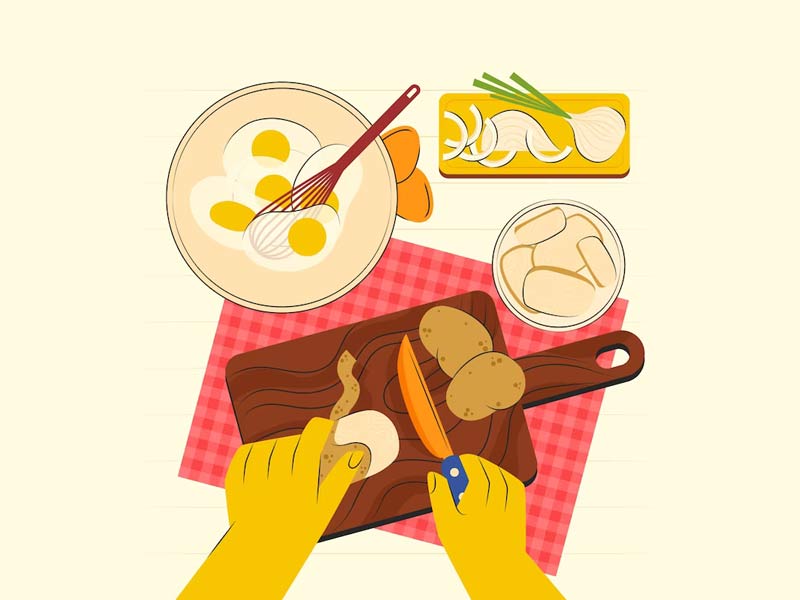Blanch cooking is a culinary technique that has been employed for centuries to preserve the natural color, texture, and flavor of various foods. From vibrant vegetables to succulent fruits, blanching offers a range of benefits that elevate the overall quality of your dishes. In this comprehensive guide, we will delve into the art of blanch cooking, exploring its history, techniques, and the numerous advantages it brings to your culinary endeavors.
I. Understanding Blanch Cooking: A Brief Overview
Blanch cooking is a culinary technique that involves briefly boiling food and then rapidly cooling it in ice water. The process of blanching serves several purposes, including preserving the natural color, texture, and flavor of the food. By subjecting the food to a quick boil and immediate cooling, blanching halts enzymatic activity, which can lead to discoloration and loss of texture.
A. Definition and Origins of Blanching
Blanching, derived from the French word “blanchir,” meaning “to whiten,” has been practiced for centuries across various cultures. The term originally referred to whitening vegetables, but its scope has expanded to encompass a broader range of foods.
Blanching typically involves immersing the food in boiling water for a short period, followed by an immediate transfer to an ice bath. The ice bath rapidly lowers the food’s temperature, halting the cooking process and preserving its qualities.
B. Historical Significance and Cultural Applications
The history of blanching (Blanch Cooking) can be traced back to ancient civilizations, where methods of food preservation were crucial for survival. Early cultures, such as the Greeks and Romans, used blanching as a means to preserve fruits, vegetables, and even meats.
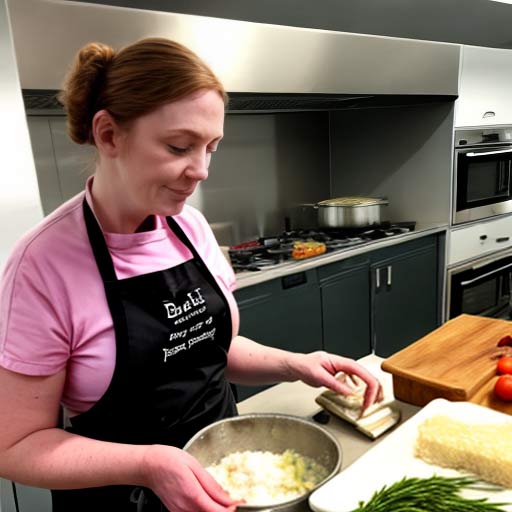
In Asian cuisine, blanching plays a significant role. Chinese and Japanese cooking often employ blanching techniques to enhance the visual appeal of vegetables, seafood, and noodles. Blanching is also a common practice in Vietnamese cuisine, particularly for dishes like spring rolls, where blanched ingredients are used as fillings.
C. How Blanching Differs from Other Cooking Methods
Blanching (Blanch Cooking) sets itself apart from other cooking methods due to its precise timing and immediate cooling process. Unlike boiling, where food is cooked fully, blanching aims to partially cook the food and retain its natural qualities.
Compared to steaming, which uses indirect heat, blanching exposes the food directly to boiling water, resulting in a more rapid cooking process. Additionally, blanching provides a cooling step that helps maintain the food’s freshness, color, and texture.
Blanching also differs from blanching. While both techniques involve a brief cooking time followed by rapid cooling, blanching is primarily used for vegetables and fruits, while blanching typically applies to meat and poultry to remove impurities and unwanted flavors.
Understanding the fundamental aspects of blanch cooking sets the stage for exploring its scientific principles, techniques, and various applications in the culinary world. In the following sections, we will delve deeper into the science behind blanching, the necessary techniques and equipment, advanced applications, troubleshooting tips, and the nutritional benefits it offers. So, let’s dive into the art of blanch cooking and unlock its potential in your kitchen!
II. The Science Behind Blanch Cooking: Why It Works
Blanch cooking is not just a culinary tradition; it is rooted in scientific principles that explain why the process is effective in preserving the color, texture, and flavor of foods. By understanding the science behind blanching, you can gain insights into the chemical reactions that occur and how they contribute to the overall success of this cooking technique.
A. Enzyme Inactivation and Preservation of Color
One of the primary reasons for blanching is to inhibit the activity of enzymes present in fruits and vegetables. Enzymes are natural substances that promote various biochemical reactions in plants, including those responsible for ripening and breaking down cell structures. However, when these enzymes are not controlled, they can cause discoloration, texture loss, and flavor changes in foods.
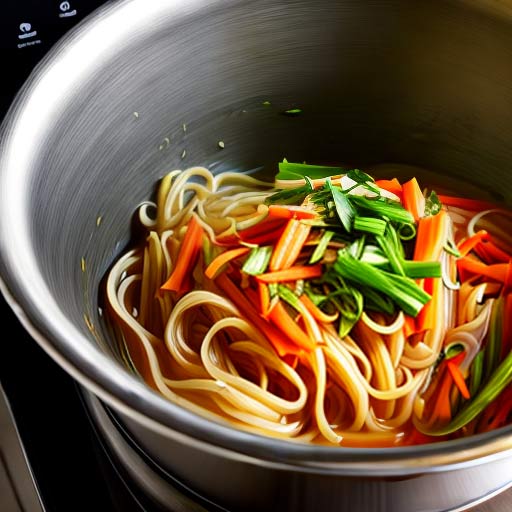
Blanching (Blanch Cooking) involves subjecting the food to a short burst of high temperature, usually in boiling water. This sudden heat denatures the enzymes, rendering them inactive. By inactivating the enzymes, blanching helps preserve the natural color of the food, keeping it vibrant and appealing.
Additionally, blanching helps to destroy bacteria and microorganisms present on the surface of the food, ensuring its safety and extending its shelf life.
B. Retention of Texture and Nutritional Value
Blanching (Blanch Cooking) also plays a crucial role in preserving the texture of foods. When vegetables and fruits are blanched, the heat causes the cell walls to soften slightly, making them more pliable. This not only helps maintain a desirable texture but also facilitates the penetration of flavors during subsequent cooking processes.
Furthermore, blanching has a minimal impact on the nutritional value of foods. The short cooking time and immediate cooling help preserve the vitamins, minerals, and other beneficial compounds present in fruits and vegetables. By preserving the nutritional content, blanching allows you to enjoy the health benefits associated with these foods.
C. Flavor Enhancement and Culinary Applications
Blanching (Blanch Cooking) can enhance the flavor of certain foods, particularly vegetables. The brief exposure to boiling water helps to unlock and intensify their natural flavors, making them more pronounced and enjoyable. Blanching also helps remove any bitter or unwanted flavors, resulting in a more pleasant taste.
In the culinary world, blanching is often used as a preparatory step for various dishes. For example, blanching vegetables before stir-frying helps to retain their vibrant colors, crisp texture, and fresh flavors. Blanching is also commonly employed when freezing fruits and vegetables, as it helps maintain their quality during storage.
Understanding the science behind blanch cooking empowers you to utilize this technique effectively in your kitchen. By controlling enzymes, preserving texture, retaining nutritional value, and enhancing flavors, blanching plays a vital role in creating visually appealing, delicious, and nutritious dishes. In the upcoming sections, we will explore the techniques and equipment necessary for successful blanching, advanced applications, troubleshooting tips, and the myriad ways blanching can elevate your culinary creations.
III. Techniques and Equipment for Blanch Cooking
To master the art of blanch cooking, it is essential to familiarize yourself with the techniques and equipment that ensure successful results. Whether you are blanching vegetables, fruits, or other ingredients, following the proper steps and utilizing the right tools will help you achieve optimal outcomes in terms of texture, color, and flavor.
A. Basic Steps for Blanching Various Foods
Blanching Vegetables: A Step-by-Step Guide
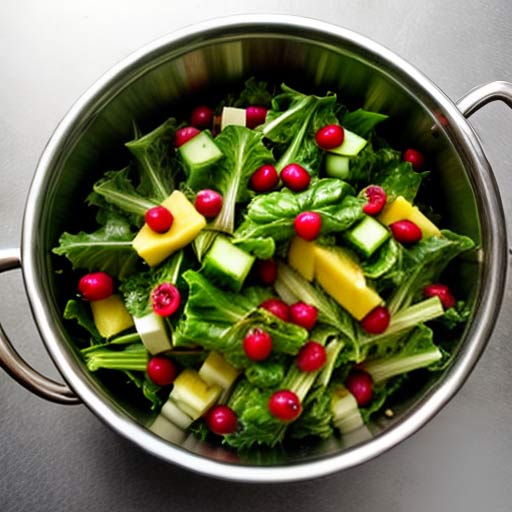
- Prepare the vegetables: Start by selecting fresh, high-quality vegetables. Wash them thoroughly to remove any dirt or impurities. Trim off any tough stems or ends, and cut them into uniform pieces for even cooking.
- Boil the water: Fill a large pot with water and bring it to a rolling boil. The pot should be large enough to accommodate the vegetables without overcrowding.
Add salt (optional):
While not mandatory, adding a small amount of salt to the boiling water can enhance the flavor of the vegetables.
- Blanch the vegetables: Carefully add the vegetables to the boiling water. Allow them to cook for a specific time depending on the vegetable’s density and desired level of tenderness. Refer to blanching time guidelines or recipes for precise durations.
- Ice bath: Using a slotted spoon or tongs, quickly remove the blanched vegetables from the boiling water and transfer them to a large bowl or sink filled with ice water. This halts the cooking process and helps preserve their vibrant color and crisp texture.
- Drain and pat dry: Once the vegetables have cooled in the ice bath for a few minutes, remove them and drain them well. Gently pat them dry using a clean kitchen towel or paper towels before using them in your desired recipe.
Blanching Fruits: Unlocking Natural Sweetness
- Prepare the fruits: Choose ripe, firm fruits and wash them thoroughly. Peel, pit, and cut them into desired sizes or slices.
- Boil the water: Similar to vegetable blanching, bring a pot of water to a rolling boil. You may choose to add a bit of lemon juice or sugar syrup to the water to help preserve the fruit’s color and flavor.
Blanch the fruits:
Carefully place the fruit pieces in the boiling water and let them cook for a short time, usually just a minute or two. This will help soften the fruits slightly without overcooking them.
- Ice bath: Using a slotted spoon or a strainer, transfer the blanched fruits to an ice bath to rapidly cool them down and halt the cooking process.
- Drain and use: Once the fruits have cooled, remove them from the ice bath and drain any excess water. They are now ready to be used in various recipes, such as pies, jams, or desserts.
B. Essential Equipment for Successful Blanching
Blanching Baskets and Sieves: Straining Made Easy
Blanching (Blanch Cooking) baskets or sieves are indispensable tools for blanching. These perforated containers allow you to submerge the food in boiling water and retrieve it effortlessly without losing any pieces. The perforations also ensure proper water circulation around the food, facilitating even cooking.
Ice Baths and Cooling Racks: Halting the Cooking Process
Ice baths are used to rapidly cool blanched foods. They consist of a large bowl or sink filled with cold water and ice cubes. Placing the blanched food in the ice bath immediately after boiling helps preserve its texture, color, and flavor by quickly lowering its temperature and stopping further cooking.
Cooling racks are useful for draining blanched foods. After removing the food from the ice bath, placing it on a cooling rack allows excess water to drain away, preventing the food from becoming waterlogged.
Boiling Water and Salt: Enhancing Flavors and Texture

A large pot of boiling water is the foundation of successful blanching. Ensure you have enough water to fully submerge the food without overcrowding the pot. The water should be brought to a rolling boil before adding the food.
Salt can be added to the boiling water to enhance the flavors of blanched vegetables. While not necessary, it can contribute to a more seasoned taste.
Mastering the proper techniques and utilizing the appropriate equipment are key to achieving excellent results when blanch cooking. By following the step-by-step process for blanching vegetables and fruits, and having essential tools like blanching baskets, ice baths, and cooling racks at your disposal, you’ll be well-equipped to explore the endless culinary possibilities blanching has to offer. In the next section, we will delve into advanced blanching techniques and applications, including freezing and food preservation, as well as utilizing blanching for improved recipe execution.
IV. Blanching Beyond the Basics: Exploring Advanced Techniques
Blanching, (Blanch Cooking) while commonly used for basic preparation of vegetables and fruits, offers a range of advanced techniques and applications that go beyond the fundamental steps. In this section, we will delve into these advanced blanching techniques, including blanching for freezing and food preservation, as well as utilizing blanching for improved recipe execution.
A. Blanching for Freezing and Food Preservation
Blanching plays a crucial role in preserving the quality and flavor of foods for long-term storage. By blanching before freezing, you can maintain the texture, color, and nutritional value of the produce. Follow these guidelines for successful blanching for freezing:
- Select the right produce: Choose fresh, ripe fruits and vegetables at their peak quality. Discard any damaged or overripe pieces.
- Prepare the produce: Wash and peel the fruits and vegetables as needed. Remove any undesirable parts, such as stems or seeds. Cut them into appropriate sizes for freezing.
- Blanching time: Blanching times may vary depending on the type of produce. It is crucial to follow recommended blanching times to achieve optimal results. Under-blanching may result in enzyme activity and nutrient loss, while over-blanching can lead to a mushy texture.
- Cooling and draining: After blanching, transfer the produce immediately to an ice bath to cool it rapidly. Drain thoroughly to remove excess water.
- Packaging for freezing: Once drained, pack the blanched produce in airtight containers or freezer bags, removing as much air as possible to prevent freezer burn. Label the containers with the contents and date.
By blanching (Blanch Cooking) before freezing, you can extend the shelf life of fruits and vegetables while retaining their quality, making them readily available for future use.
B. Blanching for Improved Recipe Execution

Blanching (Blanch Cooking) can be used as a preparatory step to improve recipe execution, especially for dishes that require precise cooking times or demand vibrant colors and textures. Here are a few examples:
- Blanching (Blanch Cooking) for Stir-Fries: When preparing stir-fried dishes, blanching certain vegetables beforehand can help retain their vibrant colors and crisp texture. Blanching vegetables like broccoli, green beans, or snow peas for a short time before stir-frying ensures they are cooked just enough to be tender-crisp and visually appealing.
- Blanching for Pasta Salads: Incorporating blanched vegetables in pasta salads can enhance their visual appeal and texture. Blanching colorful vegetables like bell peppers, carrots, or asparagus before adding them to the pasta salad helps maintain their crunchiness and prevents them from becoming soggy.
- Blanching (Blanch Cooking) for Appetizers and Pickling: Blanching is often employed for appetizers like stuffed grape leaves or pickled vegetables. Blanching ingredients like grape leaves, cabbage leaves, or pickling vegetables before using them in these recipes helps soften them, making them more pliable and easier to work with.
Utilizing blanching as a preparatory step in these advanced applications ensures that your dishes are visually appealing, retain their texture, and provide optimal cooking results.
Blanching goes beyond its basic applications, allowing you to preserve foods for longer durations and improve the execution of various recipes. By exploring these advanced blanching techniques, you can unleash your creativity in the kitchen and create flavorful dishes that delight the senses. In the next section, we will discuss troubleshooting tips and offer advice to help you achieve the best results when blanching.
V. Creative Culinary Applications of Blanch Cooking
Blanch cooking offers a myriad of creative culinary applications that go beyond basic vegetable and fruit preparation. By harnessing the power of blanching, you can unlock new flavors, textures, and presentations in your dishes. In this section, we will explore some innovative ways to incorporate blanching into your culinary repertoire.
A. Blanching for Vibrant Vegetable Noodles
Vegetable noodles, or “zoodles,” have gained popularity as a healthy alternative to traditional pasta. Blanching vegetables like zucchini, carrots, or sweet potatoes before spiralizing them helps soften their texture slightly while maintaining their vibrant colors. The blanched vegetable noodles can then be quickly sautéed or served raw, adding a refreshing and colorful twist to your meals.
B. Blanching for Refreshing Cold Salads
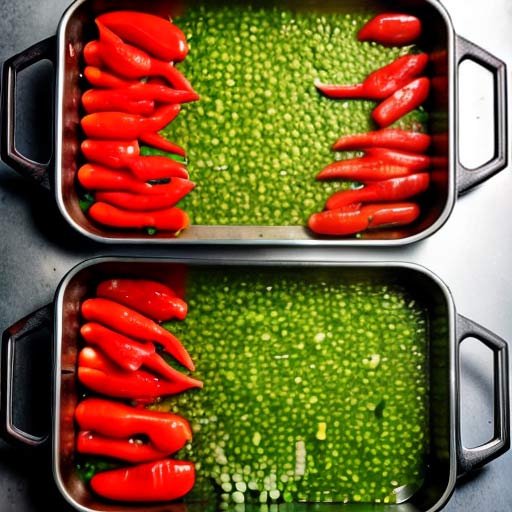
Blanching is an excellent technique to prepare vegetables for cold salads, adding a crisp and vibrant touch. For example, blanching green beans, snap peas, or asparagus for a short time and then immersing them in an ice bath creates a refreshing and crunchy element in salads. Combine them with other ingredients like cherry tomatoes, feta cheese, and a tangy dressing for a delightful summer salad.
C. Blanching for Stuffed Vegetables
Blanching (Blanch Cooking) vegetables like bell peppers, cabbage leaves, or zucchini boats before stuffing them enhances their pliability and facilitates the cooking process. By blanching these vegetables, you can achieve a tender texture while preserving their structural integrity. Fill them with a variety of flavorful fillings such as rice, ground meat, or cheese, and bake them for a satisfying and visually appealing dish.
D. Blanching for Colorful Vegetable Wraps
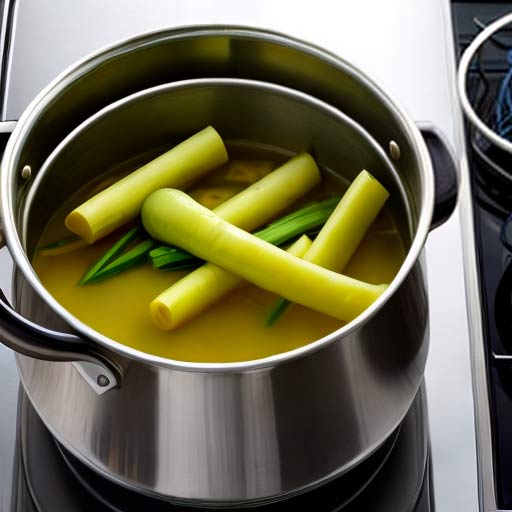
Blanching vegetables such as collard greens, Swiss chard, or lettuce leaves allows you to create vibrant and nutritious wraps. The blanching process softens the leaves, making them more flexible for wrapping around fillings like seasoned tofu, quinoa, or grilled vegetables. These colorful vegetable wraps provide a refreshing alternative to traditional tortilla or bread-based wraps.
E. Blanching for Vivid Vegetable Purees and Sauces
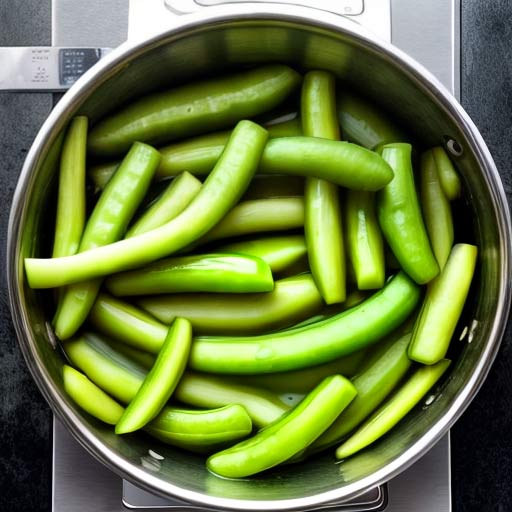
Blanching vegetables before blending them into purees or sauces helps retain their vibrant colors and nutrients. Vegetables like spinach, peas, or broccoli can be blanched briefly and then pureed with other ingredients like garlic, herbs, or cream to create vibrant and flavorful sauces. These vegetable purees and sauces can be used as accompaniments to meat, fish, or pasta dishes, adding both visual appeal and taste.
F. Blanching for Quick Pickles
Blanching (Blanch Cooking) is a valuable technique for creating quick pickles that retain the crunchiness and color of vegetables. By blanching vegetables like cucumbers, radishes, or carrots for a short time, you can slightly soften them before immersing them in a vinegar-based pickling solution. The blanching step ensures that the pickles retain their texture while absorbing the flavors of the pickling liquid more effectively.
Blanch cooking opens up a world of creative possibilities in the kitchen. By applying blanching techniques to vegetable noodles, cold salads, stuffed vegetables, wraps, purees, sauces, and quick pickles, you can elevate your dishes with vibrant colors, refreshing textures, and exciting flavors. Get adventurous and experiment with blanch cooking to add a touch of innovation to your culinary creations.
In the next section, we will provide troubleshooting tips and address common challenges that may arise during the blanching process to help you achieve the best results.
VI. Troubleshooting and Tips for Successful Blanching
Blanching (Blanch Cooking) is a versatile cooking technique, but like any culinary process, it can present challenges. To ensure successful blanching and overcome common issues, it’s helpful to have troubleshooting tips and useful advice at your disposal. In this section, we will address potential problems that may arise during the blanching process and offer tips for achieving optimal results.
A. Preventing Overcooking
Overcooking is a common pitfall in blanching (Blanch Cooking) that can result in mushy textures and loss of flavor and nutrients. To prevent overcooking:
- Follow recommended blanching times: Each vegetable or fruit has its own optimal blanching time. Refer to blanching time guidelines or reliable recipes to determine the appropriate cooking duration. It’s better to under-blanch slightly, as you can always cook the food further in subsequent cooking methods if needed.
- Monitor the blanching process: Keep a close eye on the food as it blanches. Use a timer to ensure accurate timing. Once the blanching time is up, immediately transfer the food to an ice bath to halt the cooking process.
- Test for doneness: To avoid overcooking, periodically check the texture of the food during blanching. Remove a piece and taste it to ensure it has reached the desired level of tenderness.
B. Retaining Vibrant Colors
Preserving the vibrant colors of vegetables and fruits is a crucial aspect of blanching (Blanch Cooking). To retain the natural hues:
- Use sufficient water: Ensure that you have enough boiling water to fully submerge the food without overcrowding. Overcrowding can lead to uneven cooking and color loss.
- Ice bath immediately: After blanching, transfer the food to an ice bath promptly. The rapid cooling process helps set the colors and preserves their vibrancy.
- Avoid over-soaking in the ice bath: While it’s important to cool the blanched food in an ice bath, prolonged soaking can leach out the colors. Cool the food just until it is no longer warm, and then remove it from the ice bath.
C. Achieving Optimal Texture
Texture is a crucial aspect of blanching (Blanch Cooking). To ensure desirable texture:
- Prepare the food uniformly: Cut vegetables and fruits into uniform sizes to promote even cooking. This helps achieve consistent texture throughout the food.
- Don’t over-blanch for crispness: If you desire a crisp texture, blanch the food for the minimum recommended time. This will soften the food slightly while retaining its crunchiness.
- Drain well after blanching: Thoroughly drain the blanched food to remove excess moisture, preventing it from becoming waterlogged and losing its desired texture.
D. Adjusting for Altitude and Freshness
Altitude and the freshness of the produce can affect blanching times. Keep the following in mind:
- Altitude adjustment: At high altitudes, water boils at lower temperatures. Increase the blanching time slightly to compensate for the lower boiling point. Refer to altitude adjustment guidelines for more precise adjustments.
- Freshness impact: Fresher produce may require shorter blanching times, as they tend to cook more quickly than older or less fresh ingredients. Monitor the texture and tenderness closely to avoid overcooking.
E. Quick Tips for Successful Blanching
Consider the following additional tips to enhance your blanching experience:
- Work in batches: If blanching a large quantity of food, it’s better to work in smaller batches to avoid overcrowding the pot, ensuring even cooking and color preservation.
- Use a timer: Accurate timing is crucial in blanching. Utilize a kitchen timer or set a timer on your smartphone to prevent overcooking or undercooking.
- Label and date frozen produce: If you’re blanching for freezing, label the containers or freezer bags with the contents and the date of blanching (Blanch Cooking). This helps maintain organization and ensures proper usage of frozen produce.
- Experiment with seasonings: While blanching itself doesn’t typically involve seasoning, you can add flavor to the blanched food later. Consider experimenting with herbs, spices, or dressings to enhance the taste after blanching.
Blanching can be a rewarding cooking technique when executed properly. By troubleshooting potential issues and following these tips, you’ll be well-equipped to achieve successful blanching results. In the final section, we will summarize the key points discussed throughout this article and emphasize the versatility and benefits of blanch cooking in the culinary world.
VII. Blanch Cooking: A Healthy and Nutritious Choice
Blanch cooking not only offers culinary versatility but also provides numerous health benefits. In this final section, we will summarize the key points discussed throughout this article and emphasize the health advantages of incorporating blanch cooking into your diet.
A. Retention of Nutrients
Blanching helps to preserve the nutritional value of fruits and vegetables. By blanching briefly and then cooling them rapidly, you can slow down the enzymatic activity that leads to nutrient loss. This technique allows you to retain essential vitamins, minerals, and antioxidants that are beneficial for overall health.
B. Improved Digestibility
Blanching vegetables and fruits softens their texture, making them easier to chew and digest. This is particularly advantageous for individuals with dental issues or digestive sensitivities. Blanching can also help break down certain components that might be harder to digest, such as fibers, promoting better nutrient absorption.
C. Enhanced Food Safety
Blanching is a crucial step in food safety, especially when blanching for freezing or canning. By subjecting the produce to a quick blanching process, you can eliminate surface bacteria or contaminants, reducing the risk of foodborne illnesses. Blanching also helps to extend the shelf life of preserved foods, allowing you to enjoy them safely over an extended period.
D. Colorful and Appetizing Presentation
Blanching helps to preserve the vibrant colors of fruits and vegetables, resulting in visually appealing dishes. The bright and enticing colors of blanched produce can enhance the overall dining experience and entice individuals to consume a wider variety of fruits and vegetables.
E. Versatility in Culinary Applications
The versatility of blanch cooking allows for a wide range of culinary applications. From incorporating blanched vegetables in salads and stir-fries to creating vibrant purees, wraps, and pickles, blanching opens up endless possibilities in the kitchen. It provides a fresh and nutritious element to your meals, allowing you to experiment with different flavors, textures, and presentations.
Conclusion of Blanch cooking
Blanch cooking is a valuable technique that combines the benefits of preserving nutrients, enhancing food safety, and creating visually appealing dishes. By understanding the science behind blanching, mastering the techniques, and utilizing the appropriate equipment, you can unlock the full potential of this cooking method.
Whether you’re blanching for freezing, preparing crisp salads, or exploring innovative recipes, blanch cooking offers a healthy and nutritious approach to food preparation. So, embrace the art of blanching and embark on a culinary journey filled with vibrant colors, tantalizing flavors, and wholesome nutrition.
Remember to experiment, adapt recipes to suit your taste preferences, and enjoy the nourishing and delicious results that blanch cooking can bring to your table.
Happy blanching!
Please follow us on linkedin. You can learn all best french food recipe and best Italian food recipe and best arabic food recipes and best canadian food recipes you can check our Reddit page. Don’t forget Fighting Obesity Magazine.

